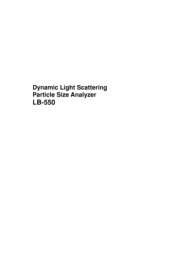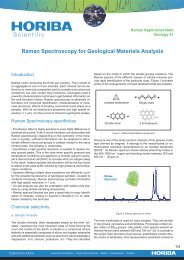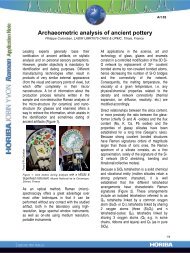OEM spectro Catalogue - Horiba
OEM spectro Catalogue - Horiba
OEM spectro Catalogue - Horiba
You also want an ePaper? Increase the reach of your titles
YUMPU automatically turns print PDFs into web optimized ePapers that Google loves.
8<br />
All gratings exhibit some amount of scattered<br />
light. The inherently lower scatter of holographic<br />
gratings improves the system performance.<br />
Concave grating designs have two additional<br />
design advantages, with respect to system stray<br />
light, over most commercial plane grating designs.<br />
First, grating scatter in Czerny Turner and<br />
Fastie Ebert designs is collected and focused,<br />
by the focusing mirror, toward the exit port. In<br />
concave grating designs the grating does not<br />
focus its own scattered light into the focal plane.<br />
Secondly, rediffracted light is minimized.<br />
Rediffracted light is light that is diffracted by the<br />
grating and redirected back to the grating a<br />
second time (unintentionally of course).<br />
When other concave optics (collimating and<br />
focusing mirrors) are used in an instrument design<br />
it is more likely that light may be rediffracted.<br />
Careful design effort is necessary to prevent<br />
rediffracted light.<br />
Concave gratings are immune from this problem<br />
when working at f-numbers greater than f/2 with<br />
low groove density (< 600 gr/mm) gratings.<br />
point<br />
spherical<br />
aberration<br />
optical<br />
coma<br />
system<br />
point<br />
astigmatism<br />
spot diagrams from a point<br />
chromatic<br />
aberration<br />
optical<br />
system<br />
spot diagrams from a point<br />
Aberration correction<br />
Aberration correction is the most important<br />
benefit of concave aberration corrected holographic<br />
gratings.<br />
To understand the benefit of aberration correction<br />
it is important to understand the main aberrations<br />
in <strong>spectro</strong>meter designs and their impact<br />
on system results.<br />
Optical components can create errors in an<br />
image even if they are made of the best materials<br />
and have no defects. These aberrations can be<br />
grouped into several different categories: spherical<br />
aberration, coma, astigmatism, and field curvature.<br />
The effects of coma, spherical aberration, astigmatism<br />
and field curvature can cause degradation<br />
of the system’s performance. Some description<br />
is necessary for how these aberrations relate<br />
to the exit focal plane of a <strong>spectro</strong>meter.<br />
coma<br />
chromatic<br />
aberration<br />
spherical<br />
aberration<br />
astigmatism

















